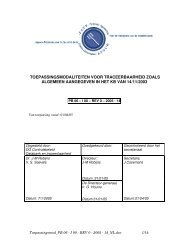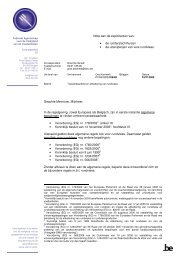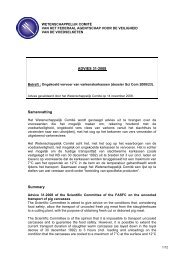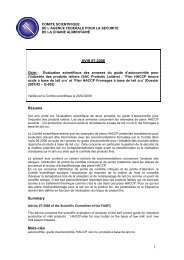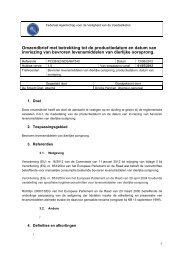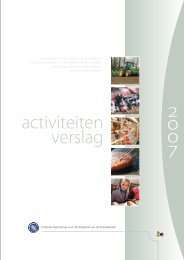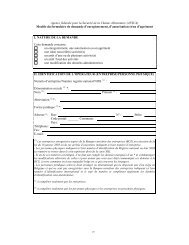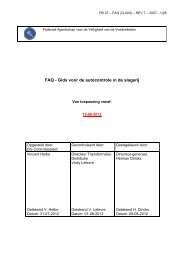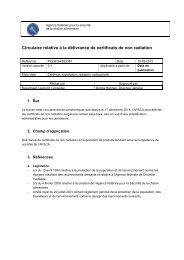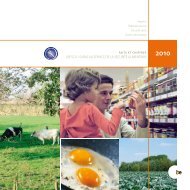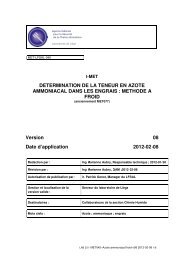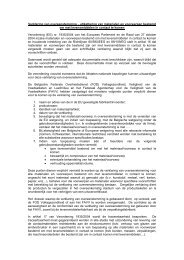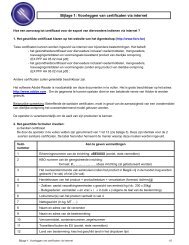Document - FAVV
Document - FAVV
Document - FAVV
- No tags were found...
Create successful ePaper yourself
Turn your PDF publications into a flip-book with our unique Google optimized e-Paper software.
Evaluation of immunoassay kits for determination of ochratoxin A in cerealsAfter centrifugation and removal of the upper-layer (0.5 ml H 3PO 4), the mixture is vortexed, recentrifuged andevaporated. The residue is than reconstituted in the proprietary extraction buffer. After a final defatting step withhexane the extract is ready to be pipetted on the plate. The more complex extraction procedure withdichloromethane and defatting with hexane should result in a cleaner extract and thus less matrix interference. Fromthe results it can be clearly seen that the amount of OTA necessary to obtain a 50% signal reduction is highlydependent of the matrix and decreases significantly in matrix, suggesting a matrix effect. When the matrix is dilutedthe IC 50 increases to the value obtained for the solvent (but not for oats), suggesting the matrix effect becomessuppressed by diluting.Table 66: Matrix-effect calculated as relative (IC50) extinctionControlOTAWheatUndilutedWheatDilutedWinter BarleyUndilutedWinter BarleyDilutedOatsUndilutedOatsDilutedSlope -1.140 -1.905 -1.178 -1.608 -0.944 -0.195 -0.851Intercept 1.798 2.814 1.813 2.221 1.488 0.205 1.157R 2 0.834 0.921 0.986 0.856 0.935 0.876 0.985SE Intercept 0.319 0.350 0.089 0.413 0.156 0.046 0.067SE Slope 0.293 0.322 0.082 0.380 0.144 0.042 0.062IC50 (ng/g) 37.760 29.992 34.556 24.067 37.666 11.203 22.893RelativeCrossreactivity100% 79% 92% 64% 100% 30% 61%Table 67: Matrix-effect calculated as percentage color reduction to the control (%CCR)ControlOTAWheatUndilutedWheatDilutedWinter BarleyUndilutedWinter BarleyDilutedOatsUndilutedOatsDiluted% Control ColorReduction100% 81% 95% 94% 104% 69% 88%CV / 16% 27% 17% 4% 16% 16%4.5.4 AccuracyFrom Table 68 it can be seen that the statistical criterion outranges the actual value of the reference material. Thelarge SD and interquartile distance clearly indicate a large variability in the results. During the work in the lab we hadalso some difficulties of obtaining good reproducible results for the calibration curve. The kit didn‟t generate anyfalse negative results however.Table 68: Accuracy on two reference materialsFAPASBIPEATRUE VAL (ng/g) 4,130 13,250N 3 3Degrees of freedom 2 2t (95) 4,130 4,130SD (ng/g) 1,874 10,765Q1 (ng/g) 2,393 15,924Q3 (ng/g) 3,730 29,345Mean (ppb) 3,138 22,069xe-xt (ng/g) 0,992 -8,819Criterium (ng/g) 4,469 25,670CODA-CERVA | Experimental evaluation 4-61




